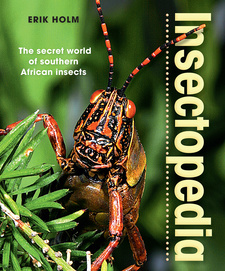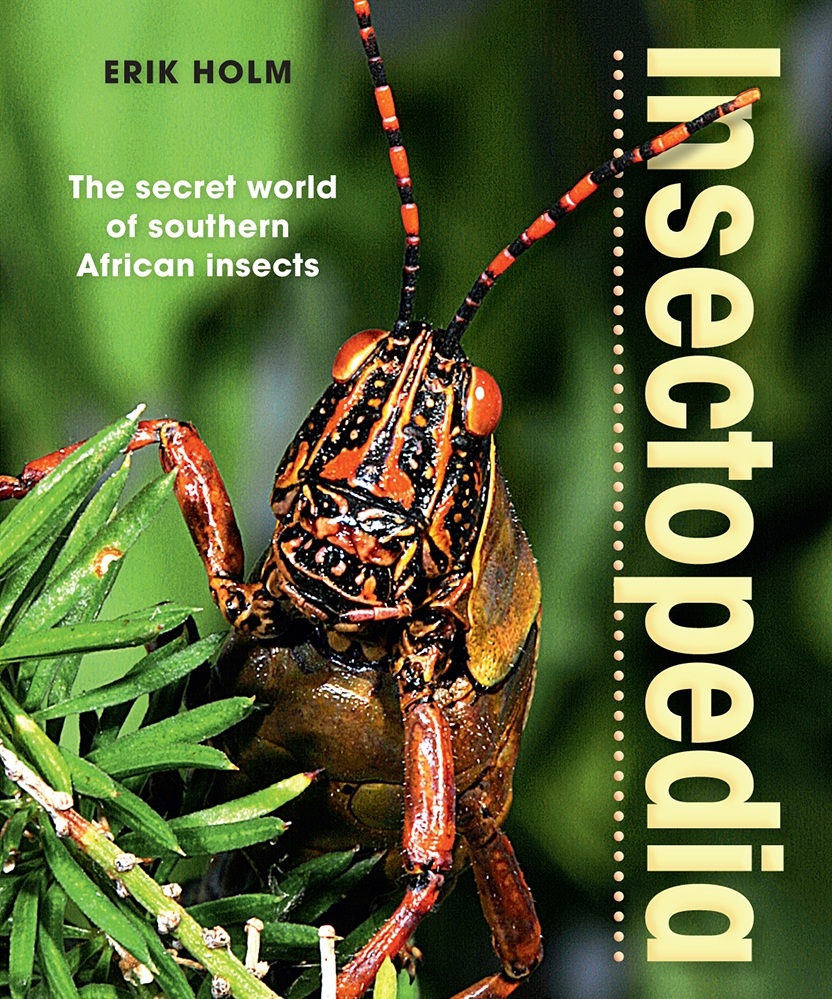Insectopedia. The secret world of southern African insects, by Erik Holm.

Insectopedia. The secret world of southern African insects, by Erik Holm. Struik Nature. Penguin Random House South Africa. Cape Town, South Africa 2017. ISBN 9781775841982 / ISBN 978-1-77584-198-2
Introduction to the world of insects: Insectopedia - The secret world of southern African insects, by Erik Holm, who is an emeritus professor and a former Head of Entomology, University of Pretoria.
Planet Earth is undoubtedly the domain of insects. An estimated three-quarters of all living species are insects, and no terrestrial ecosystem could function without them. Insects are of immense and unimaginable importance in the ecology of our world - more so than all the other animals on our planet combined. As pollinators they play a critical role in sustaining the web of life. Without species such as bees, wasps, ants, butterflies, moths and beetles, the world's ecosystems would in all likelihood collapse. Despite their many benefits, insects can justifiably also be regarded as pests. Even with all the knowledge and technology at our disposal, we cannot prevent them from devouring at least 20 per cent of agricultural crops grown for human consumption. It may be better to relinquish this share voluntarily, as the cost of using chemicals or other means to control insect pests is often equal to, or higher than, the cost of crop losses. Insects also carry diseases. It is estimated that more people have died from contracting illnesses such as malaria, yellow fever, typhus and plague, transmitted by insects, than from all other causes of death combined. Why is our knowledge of these creatures so limited? Probably because they are so much smaller than we are; it's the bigger creatures, such as the huge land mammals, which make up only one tenth of all vertebrates, that we notice. Most insects are about two millimetres in length and are, therefore, relatively inconspicuous. However, for us to ignore them would be unwise, not least because they are among the most fascinating and extraordinary of nature's many wonders. Insects have 'technology' that we could only dream of, such as the ability of fireflies to produce completely cold light, and mechanisms of flight that are beyond our understanding. The intention of this book is not to identify the roughly 80,000 insect species in our region in the manner of an ordinary field guide - this would be an impossible task. Rather, it is to describe the incredible behaviours and activities of insects, which outstrip some of the best efforts of humans.
In the Beginning
About 350 million years ago, durfng the arthropods crawled from the oceans and began colonising the new continents. Fifty million years earlier, plants had started growing on land.The marine arthropods were partly scorpion-like, partly worm-like, and had numerous legs. From them the first terrestrial arthropods and the first known insects developed - the first primitive fish moths, mayflies, dragonflies and cockroaches. Several insect orders that had originated during the Carboniferous period, as well as half of all species on earth, perished 100 million years later, at the end of the Permian period.This extinction was the result of catastrophic carbon dioxide poisoning of the atmosphere. Before this disaster happened, insects had diversified enormously: virtually all the insect orders we know today originate from that period, with some members of these orders having survived the catastrophe. Two other mass extinctions, both caused by meteorites, apparently had little effect on insect diversity.The first of these occurred towards the end of the Triassic period (about 210 million years ago) and caused the extinction of our primitive mammal-like reptiles (Karoo fossils) and most of the gymnosperm plants.The second occurred at the end of the Cretaceous period (about 65 million years ago) and led to the extinction of, among others, the dinosaurs on land and the ammonites in the oceans. [...]
This is an excerpt from Insectopedia. The secret world of southern African insects, by Erik Holm.
Title: Insectopedia
Subtitle: The secret world of southern African insects
Author: Rita van Dyk
Imprint: Struik Nature
Publisher: Penguin Random House South Africa
Cape Town, South Africa 2017
ISBN 9781775841982 / ISBN 978-1-77584-198-2
Softcover, 18 x 22 cm, 208 pages, throughout colour photos and images
Holm, Erik im Namibiana-Buchangebot
Insectopedia: The secret world of southern African insects
Fully revised and redesigned, Insectopedia, The secret world of southern African insects, includes up-to-date information throughout, an expanded ID section, and several hundred new photographs.

